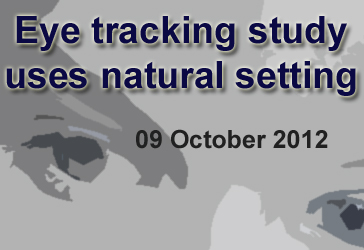Check out other stories from the Latest News
Researchers Study Eye Tracking in Natural Environment
By Stacy W. Kish on October 9, 2012

Background: One characteristic of Autism Spectrum Disorder (ASD) is the avoidance of making or maintaining eye contact. Instead, autistic children tend to focus on they eyebrows, mouth, or other facial features. Scientists hypothesize that avoiding eye contact narrows the development of the social brain network.
What’s new: Unlike previous studies set in a clinical setting, this study examined the gaze of autistic and typically developing children in a natural environment. Each child wore a device to monitor their gaze as s/he responded to and engaged in normal forms of play. During these interactions, the researchers measured the direction of gaze and the child’s field of vision. The autistic children in the study avoided the face of the experimenter more than children in the control group did. The autistic children also used their lateral field of view and looked downward more than the control group.
Why it’s important: Researchers study the gaze of autistic children to understand how the disorder affects child development. Studies in a natural setting are rare, and this work provides a unique perspective in this area of research. Future work could build on these findings by studying how head motion and focus on non-social stimuli could lead to development of novel diagnostic tools
Help me understand :
| Source(s) : |
| Tweet |

